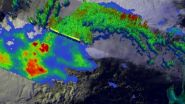(Press-News.org) Many of the world's most important crop-producing countries will be fully saturated with pests by the middle of the century if current trends continue, according to a new study led by the University of Exeter.
More than one-in-ten pest types can already be found in around half the countries that grow their host crops. If this spread advances at its current rate, scientists fear that a significant proportion of global crop-producing countries will be overwhelmed by pests within the next 30 years.
Crop pests include fungi, bacteria, viruses, insects, nematodes, viroids and oomycetes. The research, published today in the journal Global Ecology and Biogeography, describes the patterns and trends in their spread, using global databases to investigate the factors that influence the number of countries reached by pests and the number of pests in each country.
Dr Dan Bebber of Biosciences at the University of Exeter said: "If crop pests continue to spread at current rates, many of the world's biggest crop producing nations will be inundated by the middle of the Century, posing a grave threat to global food security."
The study identifies the pests likely to be the most invasive in coming years, including: three species of tropical root knot nematode whose larvae infect the roots of thousands of different plant species; Blumeria graminis, a fungus that causes powdery mildew on wheat and other cereals; and the Citrus tristeza virus (given its name meaning 'sadness' in Portuguese and Spanish by farmers in the 1930s) which had reached 105 of 145 countries growing citrus by 2000.
Fungi lead the worldwide invasion of crops and are the most widely dispersed group, despite having the narrowest range of hosts.
The study looked at the current distributions of 1,901 crop pests and pathogens and historical observations of a further 424 species. Significant use was made of historical CABI records, which document crop pests and diseases around the world from 1822 to the present day.
Dr Timothy Holmes, Head of Technical Solutions at CABI's Plantwise knowledge bank, said: "By unlocking the potential to understand the distribution of crop pests and diseases, we're moving one step closer to protecting our ability to feed a growing global population. The hope is to turn data into positive action."
It supports the view of previous studies that climate change is likely to significantly affect pest pressure on agriculture, with the warming Earth having a clear influence on the distribution of crop pests.
The authors also describe the global game of cat-and-mouse as crops are introduced to pest free regions and briefly thrive, before their pursuers catch up with them.
Professor Sarah Gurr of Biosciences the University of Exeter added: "New, virulent variants of pests are constantly evolving. Their emergence is favoured by increased pest population sizes and their rapid life-cycles, which force diversified selection and heralds the appearance of new aggressive genotypes. There is hope if robust plant protection strategies and biosecurity measures are implemented, particularly in the developing world where knowledge is scant. Whether such precautions can slow or stop this process remains to be seen."
INFORMATION:
'The global spread of crop pests and pathogens' by Daniel P. Bebber, Timothy Holmes and Sarah J. Gurr is published today in Global Ecology and Biogeography.
This research received funding from the Biotechnology and Biological Sciences Research Council (BBSRC).
New study charts the global invasion of crop pests
2014-08-28
ELSE PRESS RELEASES FROM THIS DATE:
The Lancet journals: Three-quarters of depressed cancer patients do not receive treatment for depression but a new approach could transform their care
2014-08-28
Three papers published in The Lancet Psychiatry, The Lancet, and The Lancet Oncology reveal that around three-quarters of cancer patients who have major depression are not currently receiving treatment for depression, and that a new integrated treatment programme is strikingly more effective at reducing depression and improving quality of life than current care.
An analysis of data from more than 21 000 patients attending cancer clinics in Scotland, UK, published in The Lancet Psychiatry, found that major depression is substantially more common in cancer patients than ...
Better health care as important as controlling risk factors for heart health
2014-08-28
Hamilton, ON (August 27, 2014) – Keeping a healthy heart may have as much to do with the quality of health care you have available as it does you avoiding risk factors such as smoking, bad diet and little exercise.
A large international study led by researchers at the Population Health Research Institute at McMaster University and Hamilton Health Sciences has found a that low-income countries which have people with the lowest risk factors for cardiovascular problems have the highest rates of cardiovascular events and death, while the high-income countries of people with ...
Researchers investigating new treatment for multiple sclerosis
2014-08-27
MINNEAPOLIS – A new treatment under investigation for multiple sclerosis (MS) is safe and tolerable in phase I clinical trials, according to a study published August 27, 2014, in Neurology® Neuroimmunology & Neuroinflammation, a new online-only, freely accessible, specialty medical journal. The publication is part of the Neurology® family of journals, published by the American Academy of Neurology.
The phase I studies were the first to test the drug candidate in humans. Studies with animals showed that the drug, which is called anti-LINGO-1, or BIIB033, may be able to ...
Bundled approach to reduce surgical site infections in colorectal surgery
2014-08-27
Bottom Line: A multidisciplinary program (called a "bundle") that spanned the phases of perioperative care helped reduce surgical site infections (SSIs) in patients undergoing colorectal surgery (CRS) at an academic medical center.
Author: Jeffrey E. Keenan, M.D., of the Duke University Medical Center, Durham, N.C., and colleagues.
Background: SSIs are associated with increased complications, length of hospital stay, readmission rates and health care costs. Efforts that have used systematic approaches, called bundles, that aim to incorporate best practices across the ...
Photodynamic therapy vs. cryotherapy for actinic keratoses
2014-08-27
Bottom Line: Photodynamic therapy (PDT, which uses topical agents and light to kill tissue) appears to better clear actinic keratoses (AKs, a common skin lesion caused by sun damage) at three months after treatment than cryotherapy (which uses liquid nitrogen to freeze lesions).
Author: Gayatri Patel, M.D., M.P.H., of the University of California Davis Medical Center, in Sacramento, and colleagues.
Background: AKs are rough, scaly lesions on the skin typically found on individuals with fair complexions who have had lots of sun exposure. The lesions have the potential ...
APOE, diagnostic accuracy of CSF biomarkers for Alzheimer disease
2014-08-27
Bottom Line: Cerebral spinal fluid (CSF) levels of β-amyloid 42(Aβ42) are associated with the diagnosis of Alzheimer disease (AD) and (Aβ) accumulation in the brain independent of apolipoprotein E (APOE) gene makeup.
Authors: Ronald Lautner, M.D., of Sahlgrenska University Hospital, Sweden, and colleagues.
Background: With the emergence of biomarker dementia diagnostics, interest in CSF biomarkers associated with AD, including Aβ42 and tau proteins, is increasing. The APOE gene is the most prominent susceptibility gene for late-onset AD. For the ...
NASA's TRMM Satellite sees powerful towering storms in Cristobal
2014-08-27
VIDEO:
NASA's TRMM Satellite Sees Powerful Towering Storms in Cristobal On Aug. 26, NASA's TRMM Satellite saw a band of thunderstorms with heights of over 15km (about 9.3 miles) and was...
Click here for more information.
NASA's TRMM satellite identified areas of heavy rainfall occurring in Hurricane Cristobal as it continued strengthening on approach to Bermuda.
NASA's Tropical Rainfall Measuring Mission or TRMM satellite flew above Hurricane Cristobal on August 26 at 11:35 ...
Experiments explain why some liquids are 'fragile' and others are 'strong'
2014-08-27
Only recently has it become possible to accurately "see" the structure of a liquid. Using X-rays and a high-tech apparatus that holds liquids without a container, Kenneth Kelton, PhD, the Arthur Holly Compton Professor in Arts & Sciences at Washington University in St. Louis, was able to compare the behavior of glass-forming liquids as they approach the glass transition.
The results, published in the August 6 issue of Nature Communications, are the strongest demonstration yet that bulk properties of glass-forming liquids, such as viscosity, are linked to microscopic ...
Novel 'butterfly' molecule could build new sensors, photoenergy conversion devices
2014-08-27
TALLAHASSEE, Fla. — Exciting new work by a Florida State University research team has led to a novel molecular system that can take your temperature, emit white light, and convert photon energy directly to mechanical motions.
And, the molecule looks like a butterfly.
Biwu Ma, associate professor in the Department of Chemical and Biomedical Engineering in the FAMU-FSU College of Engineering, created the molecule in a lab about a decade ago, but has continued to discover that his creation has many other unique capabilities.
For example, the molecular butterfly can flap ...
A touching story: The ancient conversation between plants, fungi and bacteria
2014-08-27
MADISON, Wis. — The mechanical force that a single fungal cell or bacterial colony exerts on a plant cell may seem vanishingly small, but it plays a heavy role in setting up some of the most fundamental symbiotic relationships in biology. In fact, it may not be too much of a stretch to say that plants may have never moved onto land without the ability to respond to the touch of beneficial fungi, according to a new study led by Jean-Michel Ané, a professor of agronomy at the University of Wisconsin-Madison.
"Many people have studied how roots progress through the soil, ...



